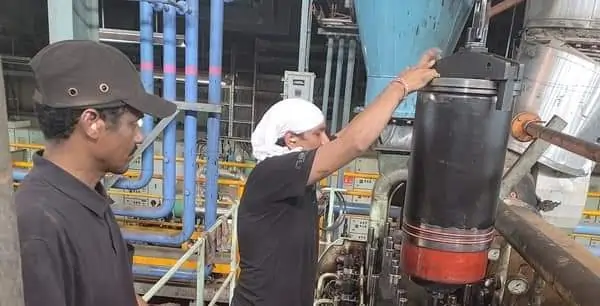Marine Diesel Engine Maintenance Tips
Did you know that regular maintenance can extend the lifespan of marine diesel engines by up to 50%? For marine engineers, proper maintenance is critical for ensuring optimal engine performance, safety, and longevity. Neglecting regular upkeep can lead to unexpected breakdowns, costly repairs, and hazardous situations at sea.
In this blog post, we present the seven most ultimate maintenance tips every marine engineer should follow. These tips are designed to keep your engines running smoothly, reduce downtime, and enhance overall vessel performance. From routine inspections to advanced diagnostic techniques, these strategies provide practical and effective solutions for maintaining your engines. Additionally, marine engineers are advised to follow the maintenance tips and schedules provided by the manufacturers of the specific engines installed onboard their ships. Dive in to discover how you can maintain peak performance and reliability in your marine diesel engines
Why Marine Engineers Neglect Engine Maintenance
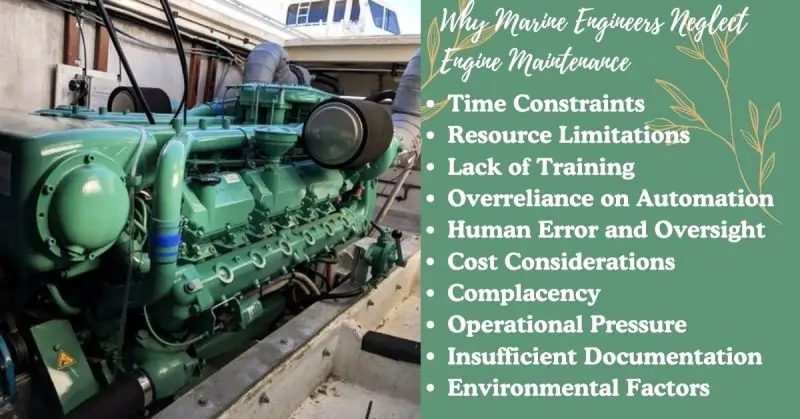
| Reason | Description |
|---|---|
| Time Constraints | Marine engineers often have demanding schedules with numerous responsibilities. The operational demands of the vessel can make it challenging to allocate sufficient time for thorough maintenance. In busy periods, routine maintenance may be deprioritized in favor of more immediate operational tasks. |
| Resource Limitations | Adequate resources, such as spare parts, tools, and proper facilities, may not always be available on board. Limited access to necessary materials can hinder the ability to perform maintenance tasks effectively. |
| Lack of Training | Marine engineers may not always receive up-to-date training on the latest maintenance techniques and best practices. This can lead to gaps in knowledge and skills necessary for effective engine maintenance. |
| Overreliance on Automation | Modern ships are equipped with advanced automated systems that monitor engine performance. This can create a false sense of security, leading engineers to believe that less hands-on maintenance is required. |
| Human Error and Oversight | Simple human error and oversight can result in neglected maintenance. Busy schedules and the complexity of marine operations can cause engineers to overlook or forget routine checks and maintenance tasks. |
| Cost Considerations | Maintaining marine engines can be expensive. The cost of parts, labor, and downtime can lead to deferred maintenance in an effort to save money. This short-term cost-saving approach can lead to more significant expenses in the long run due to potential engine failures. |
| Complacency | After extended periods without incidents or breakdowns, engineers might become complacent about regular maintenance. The absence of immediate problems can lead to a false sense of security, resulting in neglected maintenance. |
| Operational Pressure | Ships often operate under tight schedules and deadlines. The pressure to meet these schedules can result in postponed maintenance activities to ensure that the vessel remains operational. |
| Insufficient Documentation | Lack of proper documentation and records of past maintenance can lead to confusion and missed maintenance tasks. Clear and detailed logs are essential for ensuring that all necessary maintenance is performed timely. |
| Environmental Factors | Working conditions on board, such as adverse weather or rough seas, can make it difficult to carry out maintenance tasks safely and effectively. |
Regular Inspection and Diagnostics
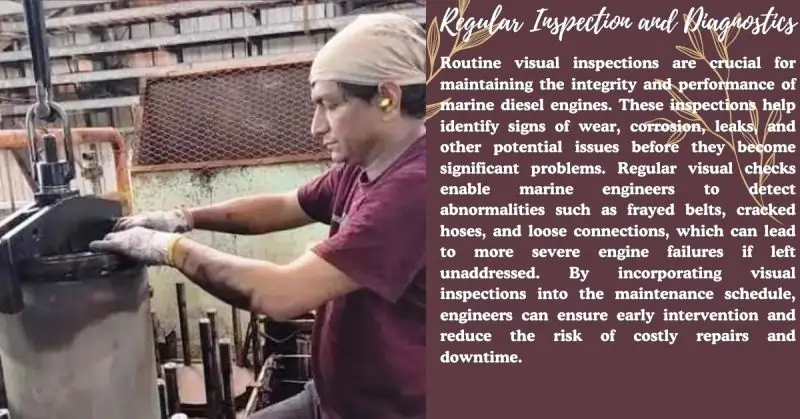
Visual Inspections
Importance of Routine Visual Checks for Signs of Wear and Damage Routine visual inspections are crucial for maintaining the integrity and performance of marine diesel engines. These inspections help identify signs of wear, corrosion, leaks, and other potential issues before they become significant problems. Regular visual checks enable marine engineers to detect abnormalities such as frayed belts, cracked hoses, and loose connections, which can lead to more severe engine failures if left unaddressed. By incorporating visual inspections into the maintenance schedule, engineers can ensure early intervention and reduce the risk of costly repairs and downtime.
Diagnostic Tools
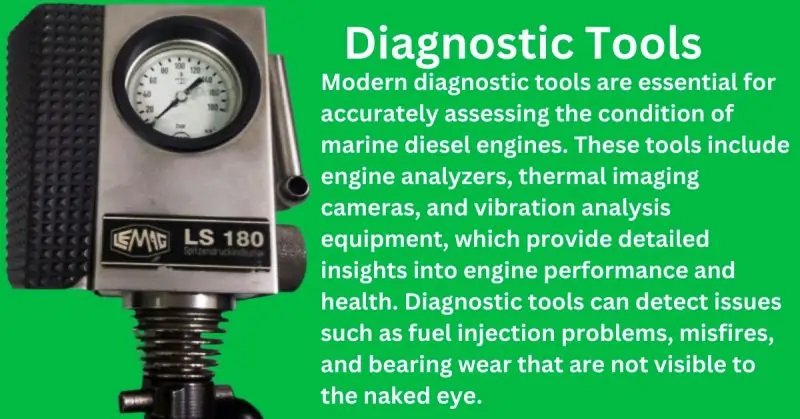
Utilizing Modern Diagnostic Tools for Early Detection of Issues Modern diagnostic tools are essential for accurately assessing the condition of marine diesel engines. These tools include engine analyzers, thermal imaging cameras, and vibration analysis equipment, which provide detailed insights into engine performance and health. Diagnostic tools can detect issues such as fuel injection problems, misfires, and bearing wear that are not visible to the naked eye. By regularly using diagnostic equipment, marine engineers can identify and address potential problems early, ensuring optimal engine performance and extending the engine’s lifespan. Utilizing these advanced tools also helps in maintaining compliance with industry standards and regulations.
Case Studies
Examples of Problems Detected Early Through Regular Inspections
- Case Study 1: Fuel Injector Issue
- Problem Detected: During a routine visual inspection, engineers noticed minor leaks around the fuel injectors.
- Action Taken: Diagnostic tools confirmed uneven fuel distribution.
- Outcome: Replacing the faulty injectors prevented a significant drop in engine performance and fuel efficiency.
- Case Study 2: Overheating Prevention
- Problem Detected: Thermal imaging revealed hotspots around the engine’s cooling system.
- Action Taken: Engineers flushed and replaced the coolant and cleaned the heat exchangers.
- Outcome: Early detection and maintenance prevented an overheating incident that could have caused severe engine damage.
- Case Study 3: Vibration Analysis
- Problem Detected: Vibration analysis tools identified unusual vibrations in the engine’s crankshaft.
- Action Taken: Further inspection revealed a misaligned bearing.
- Outcome: Realigning the bearing and performing corrective maintenance avoided a potential crankshaft failure, saving significant repair costs and downtime.
Lubrication and Oil Management
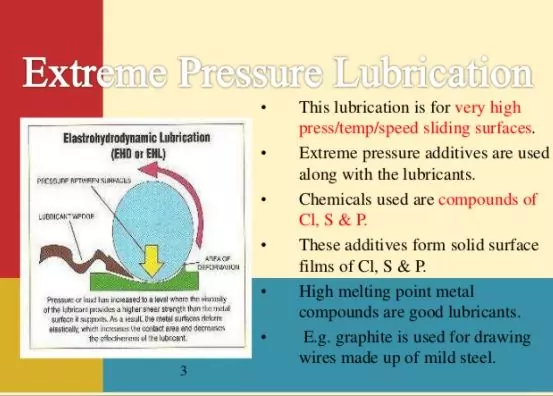
Choosing the Right Oil
Factors to Consider When Selecting Oil for Different Engine Types Selecting the appropriate oil for marine diesel engines is crucial for ensuring optimal performance and longevity. Consider the following factors when choosing the right oil:
- Engine Manufacturer’s Recommendations: Always refer to the engine manufacturer’s guidelines for oil specifications. This includes viscosity grades and performance standards.
- Viscosity: Choose an oil with the appropriate viscosity for the engine’s operating conditions. High viscosity oils are suitable for high-load and high-temperature environments, while low viscosity oils are better for cold starts and fuel efficiency.
- Additive Package: Select oils with the right additives for your engine. Additives enhance oil properties, such as anti-wear, anti-oxidation, and corrosion inhibition.
- Sulfur Content: Consider the sulfur content of the fuel being used. High sulfur fuels require oils with higher base number (BN) to neutralize acidic byproducts.
- Operating Environment: Take into account the operating environment of the vessel. For instance, engines operating in cold climates may need oils with better low-temperature properties.
Oil Change Frequency
Recommended Intervals for Changing Oil Based on Engine Usage Regular oil changes are essential for maintaining engine health and preventing wear. The recommended intervals for changing oil depend on various factors:
- Manufacturer’s Guidelines: Follow the oil change intervals specified by the engine manufacturer, which typically range from 250 to 500 hours of operation.
- Engine Load and Usage: Engines operating under high loads or in harsh conditions may require more frequent oil changes.
- Oil Analysis Results: Use oil analysis to monitor the condition of the oil and determine the optimal change intervals based on actual engine conditions.
- Type of Operation: Vessels with frequent stop-and-go operations may require shorter oil change intervals compared to those with steady-state operations.
Oil Analysis
Benefits of Oil Analysis for Predicting and Preventing Engine Failures Oil analysis is a valuable tool for predicting and preventing engine failures. The benefits of regular oil analysis include:
- Early Detection of Contaminants: Oil analysis can detect contaminants such as dirt, fuel, and coolant that may indicate engine problems.
- Monitoring Oil Condition: Analyzing oil properties such as viscosity, total base number (TBN), and oxidation levels helps determine if the oil is still effective.
- Wear Metal Detection: Identifying wear metals in the oil can indicate excessive engine wear and potential component failures.
- Extending Oil Change Intervals: Based on the analysis results, you can safely extend oil change intervals, reducing maintenance costs and downtime.
- Preventing Catastrophic Failures: Regular oil analysis helps detect issues before they become severe, preventing costly and catastrophic engine failures.
Interpretation of Oil Analysis Report: Metal Particles and Other Impurities
| Finding | Indication | Potential Issues |
|---|---|---|
| Iron (Fe) | Wear from cylinders, rings, liners, and gears | High levels indicate excessive wear or corrosion of engine components |
| Copper (Cu) | Wear from bearings, bushings, and oil coolers | Elevated levels can suggest bearing wear, corrosion, or issues with the oil cooler |
| Lead (Pb) | Wear from bearings, particularly lead-based bearings | High levels often indicate bearing wear or failure |
| Aluminum (Al) | Wear from pistons, bearings, and cylinder heads | Increased levels may signal piston scuffing, bearing wear, or aluminum component wear |
| Chromium (Cr) | Wear from piston rings and liners | Elevated chromium levels usually indicate wear in piston rings or cylinder liners |
| Nickel (Ni) | Wear from valves and turbocharger components | High nickel content can suggest valve or turbocharger wear |
| Tin (Sn) | Wear from bearings and bushings | Elevated levels may indicate bearing wear, especially in tin-plated components |
| Silicon (Si) | Contamination from dirt or dust | High silicon levels often indicate contamination from external sources like dust or gasket materials |
| Sodium (Na) | Coolant leak or contamination from seawater | High sodium can indicate coolant leakage or seawater contamination in the engine oil |
| Potassium (K) | Coolant leak | Elevated potassium levels, along with sodium, suggest coolant leakage into the oil system |
| Water (H2O) | Contamination from condensation, coolant leaks, or seawater | Presence of water can cause oil degradation and component corrosion |
| Fuel Dilution | Incomplete combustion or fuel system issues | Fuel in the oil indicates poor combustion, injector issues, or fuel system leaks |
| Oxidation | Oil degradation due to excessive heat or extended use | High oxidation levels indicate the oil is degrading and losing its effectiveness |
| Viscosity Change | Oil thickening or thinning | Changes in viscosity can indicate oil contamination, degradation, or incorrect oil usage |
By understanding the findings from oil analysis reports, marine engineers can take proactive steps to maintain engine health and performance.
Fuel System Maintenance
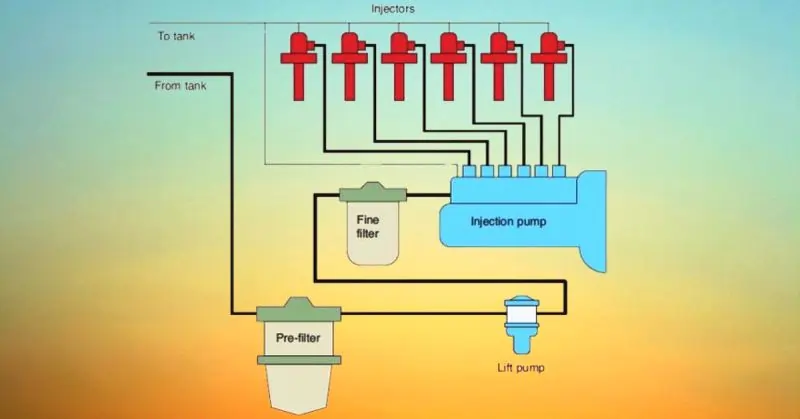
Fuel Quality
Ensuring the Use of High-Quality Fuel and Its Impact on Engine Performance Maintaining high fuel quality is essential for the optimal performance and longevity of marine diesel engines. Using high-quality fuel minimizes the risk of engine deposits, reduces wear and tear, and enhances combustion efficiency. Poor-quality fuel can contain impurities, water, and microbial growth, which can lead to clogging, corrosion, and increased emissions. To ensure the use of high-quality fuel:
- Source from Reputable Suppliers: Always procure fuel from reputable suppliers who adhere to industry standards for fuel quality.
- Regular Testing: Periodically test fuel for contaminants such as water, sulfur, and microbial content. Fuel testing can identify potential issues before they affect engine performance.
- Fuel Treatment: Consider using fuel additives to improve fuel quality. Additives can help in stabilizing fuel, dispersing water, and preventing microbial growth.
Fuel Filters
Regular Replacement of Fuel Filters to Prevent Contamination Fuel filters play a critical role in protecting the engine from contaminants present in the fuel. Regular replacement of fuel filters is vital to prevent clogging and ensure a clean fuel supply. Neglecting fuel filter maintenance can lead to decreased engine efficiency, increased fuel consumption, and potential engine damage. Key practices for maintaining fuel filters include:
- Scheduled Replacements: Follow the manufacturer’s recommended schedule for fuel filter replacement. This ensures that filters are changed before they become too clogged to function effectively.
- Monitoring Pressure Drops: Use pressure gauges to monitor for drops across the filter. A significant pressure drop can indicate that the filter is clogged and needs replacement.
- Carrying Spares: Always keep spare filters on board to enable quick replacements when needed.
Fuel System Cleaning
Methods for Cleaning the Fuel System to Maintain Efficiency Regular cleaning of the fuel system is crucial to maintain engine efficiency and prevent the buildup of contaminants that can impede fuel flow. Effective fuel system cleaning practices include:
- Fuel Polishing: Use fuel polishing systems to remove water, sludge, and other contaminants from the fuel. Fuel polishing involves circulating the fuel through a series of filters to clean it.
- Chemical Cleaning: Utilize chemical cleaners designed for diesel fuel systems. These cleaners can dissolve deposits and contaminants in the fuel lines, injectors, and tanks.
- Tank Cleaning: Periodically clean the fuel tanks to remove sludge and sediment that can accumulate over time. This process typically involves draining the tank, manually cleaning the interior, and refilling with clean fuel.
- Injector Cleaning: Ensure that fuel injectors are cleaned regularly to maintain optimal spray patterns and fuel atomization. Injector cleaning can be performed using specialized equipment or additives.
Fuel Properties Table
| Property | HSD (High-Speed Diesel) | Furnace Fuel Oil | Gas Fuel |
|---|---|---|---|
| Viscosity | 2.0-4.5 cSt @ 40°C | 180-380 cSt @ 50°C | Very low |
| Density | 0.82-0.85 g/cm³ | 0.96-1.02 g/cm³ | 0.7-0.9 kg/m³ (varies with type) |
| Calorific Value | 43-45 MJ/kg | 39-41 MJ/kg | 48-55 MJ/kg (varies with type) |
| Sulfur Content | 0.05-0.5% | 1-3.5% | <0.1% (natural gas) |
| Flash Point | >66°C | >60°C | -188°C (natural gas) |
| Pour Point | -6 to -18°C | -6 to 15°C | N/A (gas) |
Cooling System Care
Coolant Selection
Choosing the Right Coolant and Maintaining Appropriate Levels Selecting the correct coolant for marine diesel engines is crucial to prevent overheating, corrosion, and freezing. The right coolant ensures efficient heat transfer and protects engine components. Consider the following factors when choosing a coolant:
- Manufacturer’s Recommendations: Always adhere to the engine manufacturer’s specifications for coolant type and mixture ratio. This ensures compatibility and optimal performance.
- Type of Coolant: Choose between ethylene glycol-based and propylene glycol-based coolants. Ethylene glycol is more common and effective, but propylene glycol is less toxic and safer for the environment.
- Additives: Ensure the coolant contains necessary additives like corrosion inhibitors, anti-foaming agents, and pH stabilizers.
- Concentration: Maintain the correct concentration of coolant and water. Typically, a 50:50 mixture is recommended for most climates, but this can vary based on specific operating conditions.
Regularly check and maintain appropriate coolant levels to ensure the cooling system functions effectively. Low coolant levels can lead to overheating and engine damage.
Heat Exchanger Maintenance
Cleaning and Inspecting Heat Exchangers to Prevent Overheating Heat exchangers are vital for transferring heat from the engine coolant to the seawater. Regular maintenance is essential to prevent fouling and ensure efficient heat exchange. Key practices include:
- Regular Inspection: Periodically inspect heat exchangers for signs of fouling, corrosion, and leaks. Look for any buildup of marine growth, debris, or scale on the tubes.
- Cleaning Methods: Use mechanical cleaning methods, such as brushes and scrapers, to remove debris from the tubes. Chemical cleaning agents can also be used to dissolve scale and marine growth.
- End Cap Removal: Remove the end caps during inspection and cleaning to access and clean the tube bundle thoroughly.
- Leak Testing: Perform pressure testing to detect any leaks or weaknesses in the heat exchanger tubes.
Maintaining clean and efficient heat exchangers helps prevent overheating and ensures the engine operates within safe temperature limits.
Coolant System Flush
Steps for Performing a Coolant System Flush Flushing the coolant system removes old coolant, debris, and contaminants, ensuring efficient cooling and preventing corrosion. Follow these steps for a proper coolant system flush:
- Preparation: Ensure the engine is cool before starting. Wear protective gear and gather necessary tools and materials, including a new coolant, a container for old coolant, and flushing agents.
- Drain Old Coolant: Open the drain valve and remove the radiator cap to drain the old coolant into a container. Properly dispose of the old coolant according to local regulations.
- Flush the System: Close the drain valve and fill the system with a flushing agent mixed with water. Run the engine at operating temperature to circulate the flush solution. Turn off the engine and drain the system again.
- Rinse: Refill the system with clean water and run the engine again to rinse out any remaining flush solution. Drain the system once more.
- Refill with New Coolant: Close the drain valve and fill the system with the appropriate mixture of new coolant and water. Bleed any air from the system and ensure the coolant level is correct.
- Check for Leaks: Start the engine and let it run to operating temperature. Check for leaks and ensure the coolant level remains stable.
Regular coolant system flushes help maintain optimal cooling performance and extend the life of the engine.
Table of Water Qualities for Marine Diesel Engines
| Property | Recommended Values |
|---|---|
| pH | 6.5 – 8.0 |
| Hardness (as CaCO3) | < 200 ppm |
| Chlorides | < 50 ppm |
| Sulphates | < 100 ppm |
| Total Dissolved Solids (TDS) | < 500 ppm |
| Silica | < 10 ppm |
| Iron | < 0.1 ppm |
| Copper | < 0.05 ppm |
| Conductivity | < 500 µS/cm |
Maintaining proper water quality in the cooling system is essential to prevent corrosion, scaling, and fouling. Regularly test and treat the water used in the cooling system to ensure it meets these recommended values.
Air Intake and Exhaust Systems
Air Filters
Importance of Keeping Air Filters Clean and Free of Debris Air filters are crucial components of marine diesel engines, as they ensure clean air intake, which is essential for efficient combustion. Keeping air filters clean and free of debris provides the following benefits:
- Improved Engine Efficiency: Clean air filters allow unrestricted airflow, enhancing combustion efficiency and engine performance.
- Prolonged Engine Life: By filtering out dust, dirt, and other contaminants, air filters protect engine components from wear and damage, extending the engine’s lifespan.
- Fuel Efficiency: Clean air filters reduce fuel consumption by ensuring the engine operates at optimal air-to-fuel ratios.
- Reduced Emissions: Efficient combustion facilitated by clean air filters helps in reducing harmful emissions, contributing to environmental protection.
Maintenance Tips:
- Regular Inspection: Check air filters periodically for signs of clogging and dirt buildup.
- Cleaning and Replacement: Clean or replace air filters as recommended by the manufacturer. In dusty or harsh environments, more frequent maintenance may be necessary.
Turbocharger Maintenance
Regular Checks and Cleaning of Turbochargers Turbochargers play a vital role in enhancing engine power and efficiency by forcing more air into the combustion chamber. Proper maintenance of turbochargers includes:
- Inspection: Regularly inspect turbochargers for signs of wear, damage, and oil leaks. Pay attention to the condition of the turbine and compressor wheels.
- Cleaning: Clean turbochargers to remove carbon deposits and other contaminants that can impede performance. Use appropriate cleaning agents and methods recommended by the manufacturer.
- Lubrication: Ensure the turbocharger’s lubrication system is functioning correctly. Check oil levels and quality regularly to prevent bearing failures.
- Performance Monitoring: Monitor turbocharger performance parameters such as boost pressure and temperature. Any deviation from normal values can indicate underlying issues.
Benefits of Proper Turbocharger Maintenance:
- Enhanced Engine Power: Well-maintained turbochargers provide optimal boost pressure, increasing engine power and efficiency.
- Fuel Economy: Efficient turbocharging helps in better fuel atomization and combustion, improving fuel economy.
- Reduced Emissions: Properly functioning turbochargers contribute to more complete combustion, reducing exhaust emissions.
Exhaust System Inspection
Monitoring for Leaks and Ensuring Proper Exhaust Flow The exhaust system is responsible for expelling combustion gases from the engine. Regular inspection and maintenance of the exhaust system are critical for engine health and environmental compliance.
- Leak Detection: Inspect the exhaust system for leaks, particularly around joints, gaskets, and connections. Exhaust leaks can lead to dangerous emissions entering the engine room and reduced engine performance.
- Soot and Carbon Buildup: Check for soot and carbon buildup in the exhaust pipes and mufflers. Excessive buildup can restrict exhaust flow and increase backpressure, negatively impacting engine efficiency.
- Exhaust Flow: Ensure that the exhaust system is free from obstructions and that the exhaust flow is unrestricted. Proper exhaust flow is essential for maintaining optimal engine performance and preventing overheating.
- Emission Controls: Inspect components related to emission control, such as catalytic converters and particulate filters, to ensure they are functioning correctly.
Maintenance Tips:
- Regular Visual Inspections: Perform regular visual inspections of the entire exhaust system to detect any signs of damage, corrosion, or leaks.
- Pressure Testing: Conduct pressure tests to identify leaks and ensure the exhaust system is sealed properly.
- Cleaning and Replacement: Clean or replace components like mufflers and filters as needed to maintain efficient exhaust flow.
Electrical System Checks
Battery Maintenance
Regular Inspection and Care of Batteries for Reliable Starts Batteries are critical for the reliable starting and operation of marine diesel engines. Proper battery maintenance ensures they function efficiently and have a long service life. Key steps include:
- Regular Inspection:
- Visual Checks: Inspect batteries for signs of corrosion, damage, or swelling. Check terminals and connectors for cleanliness and tightness.
- Electrolyte Levels: For lead-acid batteries, check the electrolyte levels and top up with distilled water if necessary. Ensure the levels are between the recommended limits.
- Cleaning:
- Terminal Cleaning: Clean the battery terminals and connectors to remove any corrosion. Use a mixture of baking soda and water for cleaning, followed by rinsing with clean water and drying.
- Case Cleaning: Keep the battery case clean and dry to prevent corrosion and ensure proper ventilation.
- Testing:
- Voltage Testing: Use a multimeter to check the battery voltage regularly. A fully charged battery should typically read around 12.6 to 12.8 volts.
- Load Testing: Perform load testing periodically to assess the battery’s ability to hold a charge under load conditions.
- Charging:
- Proper Charging: Ensure batteries are charged correctly using an appropriate charger. Avoid overcharging, which can lead to overheating and reduced battery life.
- Trickle Charging: Use a trickle charger for batteries that are not in regular use to maintain their charge.
Wiring and Connections
Checking and Tightening Electrical Connections to Prevent Failures Proper maintenance of the electrical wiring and connections is essential to prevent failures and ensure the reliable operation of the marine engine’s electrical system. Important practices include:
- Inspection:
- Visual Inspection: Regularly inspect all wiring for signs of wear, fraying, or damage. Check for loose or corroded connections.
- Heat Damage: Look for any signs of heat damage, such as melted insulation or discolored wires, which could indicate an underlying electrical issue.
- Tightening Connections:
- Terminal Tightening: Ensure all terminal connections are tight and secure. Loose connections can lead to arcing and increased resistance.
- Connector Integrity: Check the integrity of connectors and replace any that are damaged or corroded.
- Protection:
- Proper Insulation: Ensure all wires are properly insulated to prevent short circuits. Use marine-grade wire and connectors for durability.
- Routing: Route wires away from areas of high heat and potential mechanical damage. Use cable ties and clamps to secure wiring in place.
- Testing:
- Continuity Testing: Use a multimeter to check the continuity of wires and connections. This helps identify any breaks or high resistance in the wiring.
- Voltage Drop Testing: Perform voltage drop tests to ensure there is minimal resistance in the electrical circuits.
Alternator and Starter
Ensuring the Alternator and Starter are Functioning Properly The alternator and starter are vital components of the marine engine’s electrical system. Proper maintenance and checks are essential to ensure they function reliably.
- Alternator Maintenance:
- Belt Inspection: Check the alternator belt for wear, cracks, or tension issues. Replace or adjust the belt as necessary.
- Output Testing: Use a multimeter to test the alternator’s output voltage. A properly functioning alternator should produce between 13.8 to 14.2 volts when the engine is running.
- Connection Check: Ensure all electrical connections to the alternator are secure and free from corrosion.
- Starter Maintenance:
- Visual Inspection: Inspect the starter for signs of wear, corrosion, or damage. Check the starter motor and solenoid for proper operation.
- Voltage Testing: Perform voltage drop tests on the starter circuit to ensure adequate power is reaching the starter motor.
- Engagement Check: Ensure the starter engages and disengages smoothly when starting the engine. Listen for any unusual noises that may indicate issues with the starter drive or flywheel.
- Regular Testing:
- Battery Load Test: Perform a load test on the battery to ensure it can deliver adequate power to the starter.
- Functional Test: Regularly test the starting system to ensure the engine starts promptly and reliably.
Preventive Maintenance Schedule
Creating a Schedule
Developing a Comprehensive Maintenance Schedule Tailored to Specific Engine Types Creating an effective preventive maintenance schedule is essential for ensuring the longevity and performance of marine diesel engines. A well-structured schedule should be tailored to the specific engine types and operational conditions. Steps to develop a comprehensive maintenance schedule include:
- Identify Maintenance Tasks:
- Routine Inspections: Include daily, weekly, and monthly inspection tasks such as checking oil levels, coolant levels, and inspecting belts and hoses.
- Scheduled Replacements: Identify components that require regular replacement, such as filters, belts, and fluids.
- Detailed Procedures: Outline detailed procedures for each maintenance task, ensuring consistency and thoroughness.
- Manufacturer Guidelines:
- Refer to Manuals: Use the engine manufacturer’s manuals and guidelines as the primary source for maintenance intervals and procedures.
- Warranty Requirements: Ensure the schedule complies with warranty requirements to avoid voiding warranties.
- Customizing for Operation Conditions:
- Environmental Factors: Adjust maintenance frequency based on operational conditions such as climate, load, and usage patterns.
- Usage Patterns: Engines operating under heavy loads or in harsh environments may require more frequent maintenance.
- Scheduling Tools:
- Digital Maintenance Systems: Utilize digital maintenance management systems to automate scheduling and reminders.
- Visual Aids: Create visual aids such as charts and checklists to streamline the maintenance process for the crew.
Record Keeping
Importance of Detailed Maintenance Records for Tracking and Predicting Issues Maintaining detailed records of all maintenance activities is crucial for effective preventive maintenance. Proper record-keeping helps in tracking the history of maintenance tasks, predicting potential issues, and ensuring compliance with regulatory requirements.
- Documentation:
- Maintenance Logs: Maintain logs that record the date, time, and details of each maintenance activity, including inspections, repairs, and replacements.
- Component Tracking: Track the life span and replacement dates of critical components to anticipate when they need to be serviced or replaced.
- Predictive Analysis:
- Trend Analysis: Analyze maintenance records to identify patterns and trends that may indicate recurring issues or component failures.
- Proactive Maintenance: Use historical data to plan proactive maintenance activities, preventing unexpected breakdowns.
- Compliance and Audits:
- Regulatory Compliance: Ensure maintenance records meet the requirements of maritime regulatory bodies and classification societies.
- Audit Preparedness: Maintain organized records that can be easily accessed and reviewed during audits and inspections.
Training and Updates
Keeping Up-to-Date with the Latest Maintenance Techniques and Training Opportunities Continuous training and staying updated with the latest maintenance techniques are vital for marine engineers to effectively manage and maintain marine diesel engines.
- Regular Training Programs:
- Workshops and Seminars: Participate in workshops, seminars, and conferences focused on marine engine maintenance and advancements.
- Online Courses: Utilize online training platforms that offer courses on the latest maintenance techniques and technologies.
- Certifications:
- Professional Certifications: Obtain and renew certifications from recognized maritime institutions to ensure competence in engine maintenance.
- Manufacturer Training: Attend training programs provided by engine manufacturers to gain insights into specific engine models and updates.
- Staying Informed:
- Technical Publications: Subscribe to technical publications and journals related to marine engineering and engine maintenance.
- Industry Networks: Join professional networks and forums to exchange knowledge and stay informed about industry best practices and innovations.
- Implementation of New Techniques:
- Adopt New Tools: Integrate new diagnostic and maintenance tools as they become available to improve maintenance efficiency.
- Continuous Improvement: Regularly review and update maintenance procedures based on new findings and technologies.
FAQ on “Marine Diesel Engine Maintenance Tips”
Q: How often should I change the oil?
A: Every 250-500 hours or per manufacturer’s advice.
Q: When should air filters be replaced?
A: When performance drops or filters appear dirty.
Q: How do I know if the turbocharger needs maintenance?
A: Look for unusual noises and oil leaks.
Q: Why keep maintenance records?
A: For tracking history and predicting issues.
Conclusion
Effective maintenance of marine diesel engines is crucial for ensuring their performance, reliability, and longevity. By following comprehensive schedules tailored to specific engine types, keeping meticulous maintenance records, and staying updated with the latest techniques, marine engineers can prevent costly breakdowns and enhance engine efficiency. Regular checks and care of critical components such as air filters, turbochargers, exhaust systems, batteries, wiring, and alternators are essential for optimal operation. Implementing these best practices not only improves engine performance but also contributes to safer and more cost-effective marine operations.
